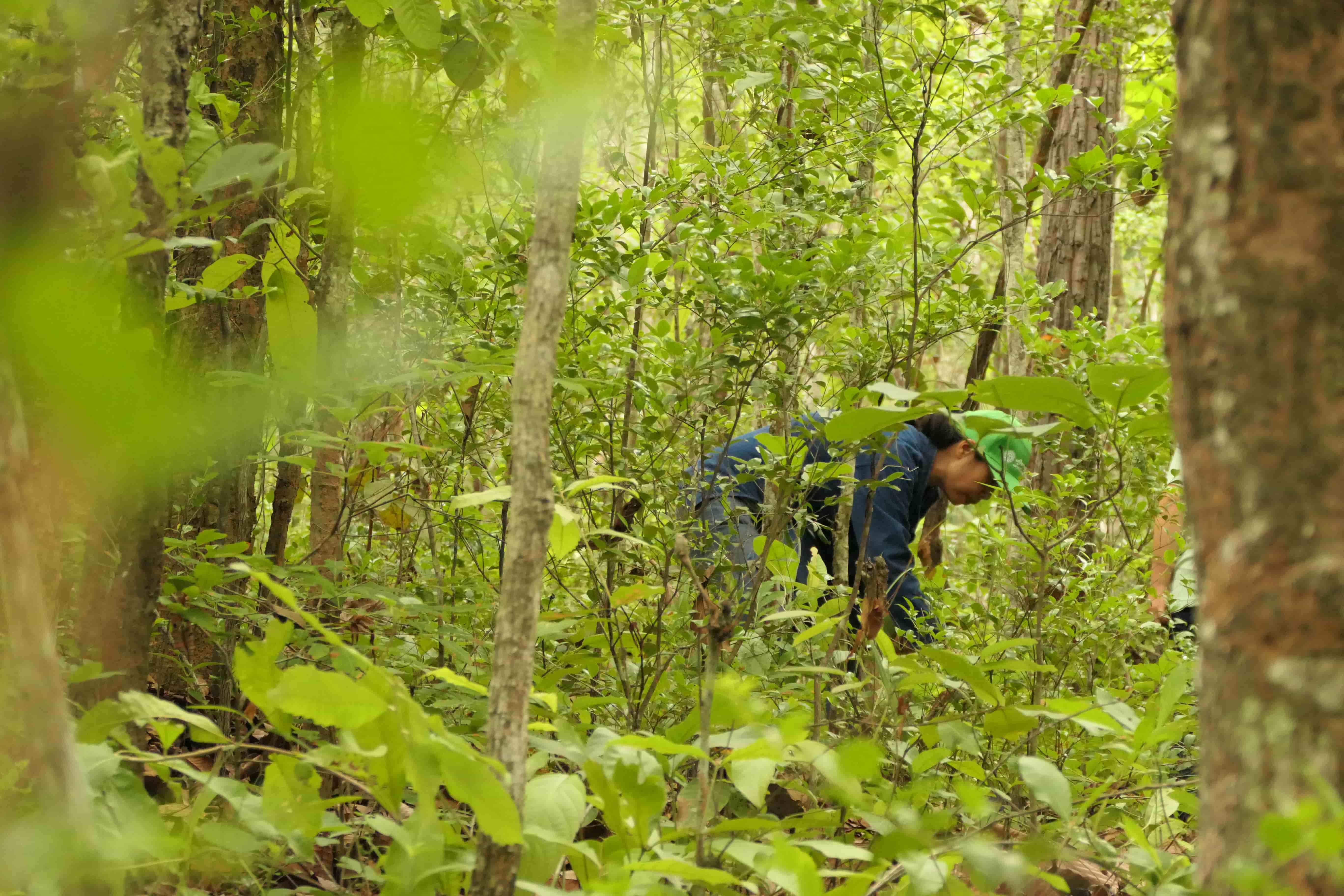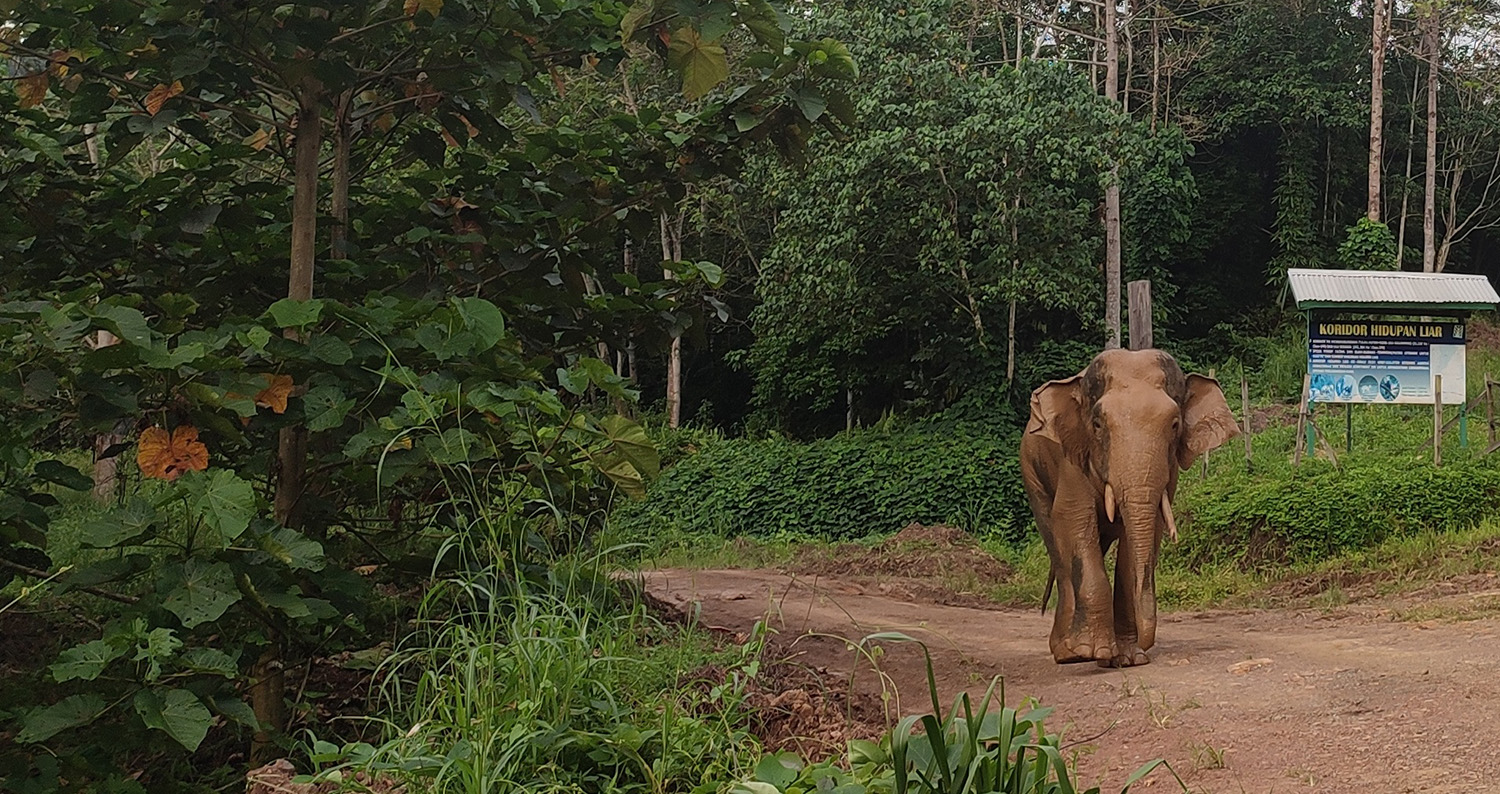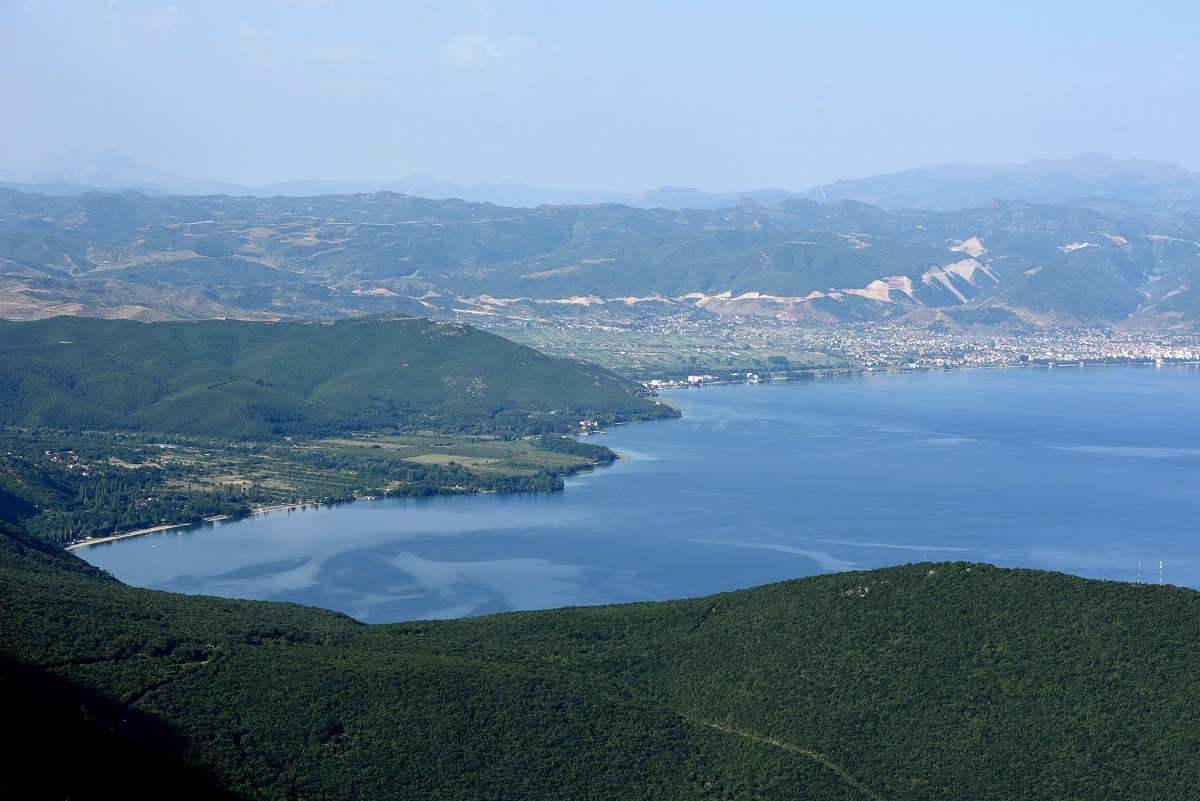Saving the Cao-vit Gibbon in northern Vietnam
The Cao-vit Gibbon (Nomascus nasutus) is one of the world’s rarest ape species and is classified as ‘Critically Endangered’ on the IUCN Red List of Threatened Species.
Gibbons and other primates in the region are severely threatened by illegal hunting, poaching, pet trade and widespread habitat degradation that is caused by agricultural practices such as cultivation and grazing. These illegal activities have left many of the world’s gibbon species close to extinction, including the Cao-vit Gibbon.
The global population of the Cao-vit Gibbon is estimated to be only 100-135 individuals, which are all located in a transboundary area in northern Vietnam and southern China. Recognizing the high level of threat that gibbon species face, it is time to step up conservation efforts to protect and conserve these ecologically and culturally important species.
The IUCN SOS Gibbons initiative is responding to this need with a goal to catalyse conservation action for some of the most threatened gibbon species. One approach implemented by the initiative is to provide grants to civil society organisations working on the frontline of conservation.
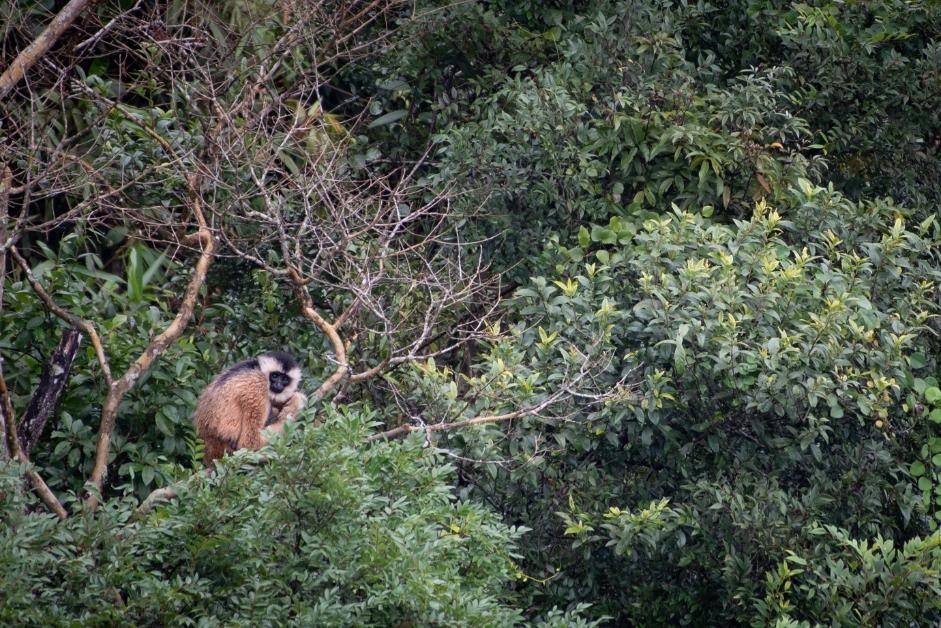 Photo: A female Cao-vit Gibbon cradles her infant. © FFI/Ollie Wearn
Photo: A female Cao-vit Gibbon cradles her infant. © FFI/Ollie Wearn
Fauna and Flora International (FFI)
FFI received a grant to support conservation action in the Cao-vit Gibbon Species and Habitat Conservation Area, the last remaining area where the species is found in Vietnam. The conservation area, located in Trung Khanh district, Cao Bang province, is characterized by dense outcrops of karst limestone covered in tropical forest.
FFI has been working in partnership with the Cao Bang Forest Protection Department (FPD) and the Management Board of Cao-vit Gibbon Species and Habitat Conservation Area since 2002. Their work involves improving protected area management capacity, engaging communities in conservation activities, strengthening transboundary cooperation between management authorities in Vietnam and China, and supporting forest rangers to conduct patrolling.
Monitoring the gibbon population
One aspect that FFI and partners have focused on is providing greater protection for gibbons in the Cao-vit Gibbon Species and Habitat Conservation Area, and gathering data about the population dynamics and habitat requirements of this unique species.
The project has established a new Cao-vit Gibbon Conservation Team consisting of 11 members including government staff and people from local communities who conduct regular monitoring of the gibbon population in the conservation area.
The team uses a number of methods to monitor the Cao-vit Gibbons. Traveling through the limestone karst valleys and peaks, the team searches for the gibbons and listens for their calls which echo throughout the valleys. Direct sightings are difficult due to the nature of the terrain in the conservation area, but over time the team has collected valuable data about the distribution, population structure, and feeding preferences of the gibbons.
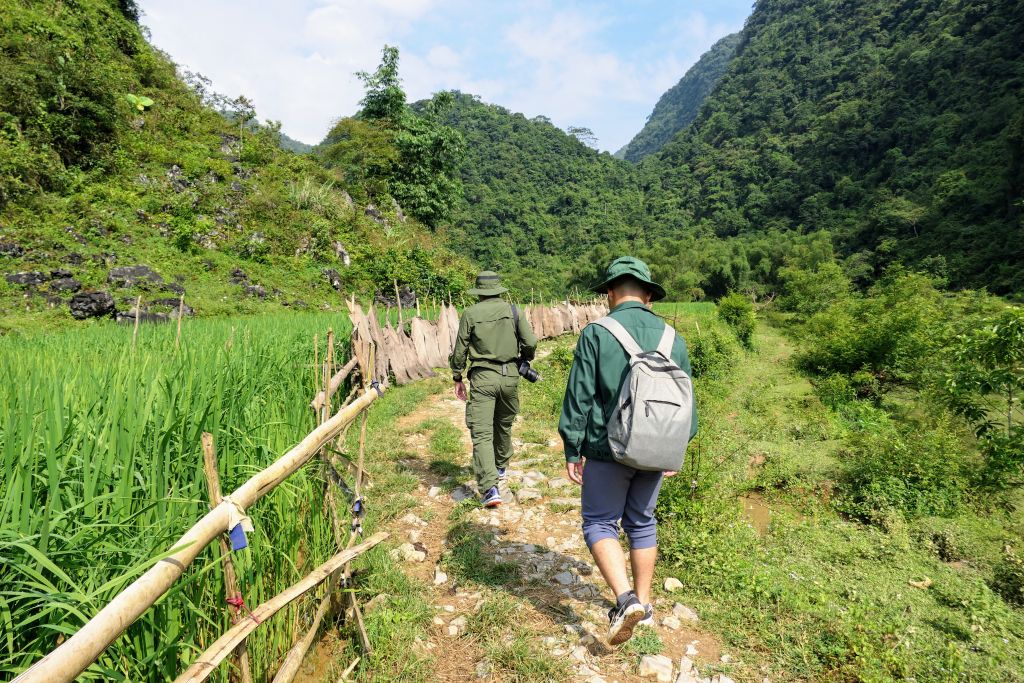 Photo: IUCN and FFI traveling by foot to the Cao-vit Gibbon Species and Habitat Conservation Area. © IUCN/Noor Ali
Photo: IUCN and FFI traveling by foot to the Cao-vit Gibbon Species and Habitat Conservation Area. © IUCN/Noor Ali
A novel method being piloted in the area is acoustic monitoring. ‘Audio moths’ are small devices that record gibbon calls. FFI has deployed 50 audio moths across the entire range of the gibbon population in the conservation area. The expectation is that data collected by these devices will help to improve the accuracy of population survey and monitoring results.
 Photo: Searching for Cao-vit Gibbons in the kart forest landscape. © FFI/Hoang Van Tuan
Photo: Searching for Cao-vit Gibbons in the kart forest landscape. © FFI/Hoang Van Tuan
Protecting gibbons and their habitat
With support from IUCN SOS Gibbons, FFI and the FPD conduct regular patrols to protect the gibbon population and the conservation area. During patrols the rangers collect data using the Spatial Monitoring and Reporting Tool (SMART). This data helps rangers and managers to monitor the performance of patrol teams and gather critical data about the presence and distribution of threats encountered in the Conservation Area. Data collected over time helps them to prioritise areas for future patrols and adapt other management strategies to address emerging threats.
From July 2020 to June 2022, 13 persons (2 rangers and 11 GCT members) conducted patrolling and monitoring in the forest between 8 and 30 days each month depending on whether and other research related duties (e.g. deploying acoustic recorders or clearing trailers in a new area). During this period, 2,632 days of patrols (13,868 hours) were conducted, covering a distance of 36,119 km. The GCT members detected 145 cases of human impacts, including 26 cases of snaring and the confiscation of 2 hunting guns.
Raising awareness
FFI has also been working to raise awareness about the presence and importance of gibbons in the area. One key target audience is youth whose support will be vital for the long-term conservation of the Cao-vit Gibbon. During November 2020, FFI hosted an outdoor environmental education course attended by 106 students, 28 teachers, Gibbon Conservation Team members, and local FPD staff. During the course, the participants learned about the gibbons and biodiversity in the area and experienced what it was like to live a day in the life of a forest ranger. To further improve awareness about the diversity of wildlife and conservation, FFI also donated materials to local schools including photos of species captured in the Conservation Area and books about biodiversity conservation.
To raise awareness of the Cao-vit Gibbon in local communities in the area, FFI also organised three Cao-vit Gibbon festivals in Phong Nam and Ngoc Khe communes over the last three years. The festivals were attended by more than 1,500 people and offered a range of activities for adults and children such as games, painting, finding food for Cao-vit Gibbon, and photo exhibitions. Communication materials such as leaflets and calendars about Cao-vit Gibbon conservation were also distributed.
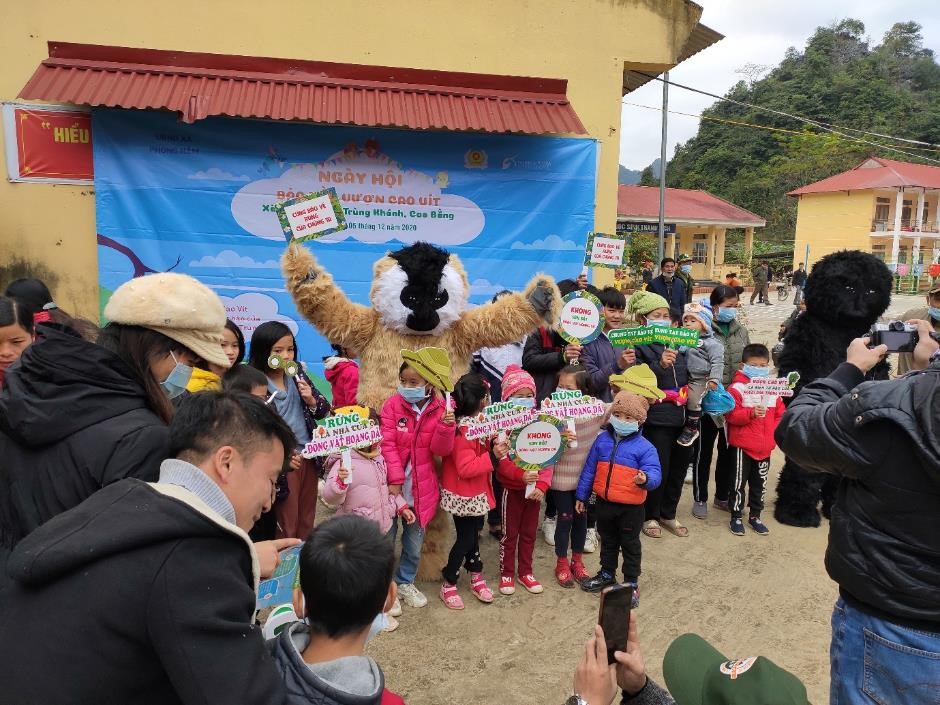 Photo: Children attending activities at the Cao-vit Gibbon Festival in Phong Nam commune, Trung Khanh District. © FFI/Nguyen Duc Tho
Photo: Children attending activities at the Cao-vit Gibbon Festival in Phong Nam commune, Trung Khanh District. © FFI/Nguyen Duc Tho
IUCN conduct a visit to Cao Bang Province
In August 2022, a team from the IUCN Asia Regional Office in Bangkok conducted a visit to Cao Bang Province to learn about the progress of the project supported by IUCN SOS Gibbons. This also provided an opportunity for IUCN to provide support and guidance for future efforts to conserve the gibbons and improve management of the Conservation Area.
After meeting with FFI in Hanoi, the team travelled to Cao Bang City in northern Vietnam. In Cao Bang, IUCN and FFI met with representatives of the Provincial People’s Committee (PPC) other local government authorities. IUCN thanked and congratulated the government on their efforts to facilitate collaboration between partners to conserve gibbons and biodiversity in Cao Bang Province.
It is clear there is a strong partnership between Cao Bang Province, Trung Khanh District, and FFI to support conservation. We can see there is an ongoing effort to maintain collaboration with local communities, engaging them in long term action that supports the conservation of the Cao-vit Gibbon and the sustainable use of natural resources upon which we all we all rely. This is very encouraging for the future of gibbons in the area - Mr. Alex McWilliam, Senior Programme Officer, Species, IUCN Asia.
Mr. Nguyen Trung Tao, Vice Chairman of the PPC, expressed his appreciation for the ongoing cooperation with FFI and support provided by IUCN. He added that continued support is needed to ensure sustained protection and management of forests and wildlife in Cao Bang Province.
The team then travelled the mountainous roads leading to Trung Khanh district where they met with officials from the district FPD who accompanied the team to the Cao-vit Gibbon Species and Habitat Conservation Area.
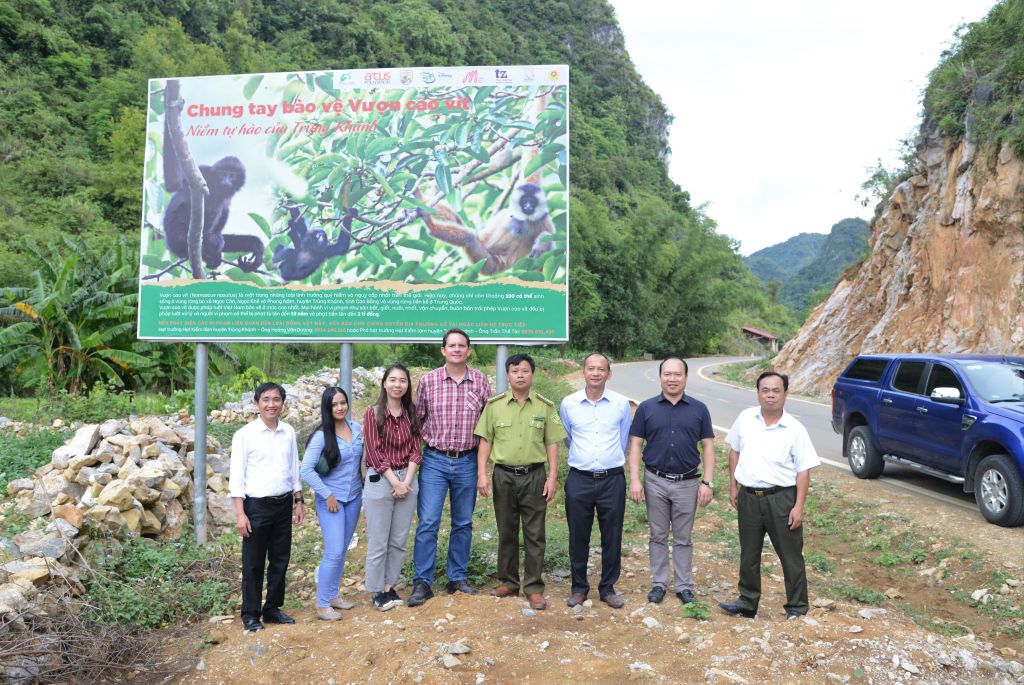 Photo: Representatives from IUCN, FFI and the FPD at the signboards in Cao-vit Gibbon Conservation Area. © FFI Vietnam
Photo: Representatives from IUCN, FFI and the FPD at the signboards in Cao-vit Gibbon Conservation Area. © FFI Vietnam
A highlight of the visit was seeing the results of efforts to restore forests in the Conservation Area. One issue limiting the distribution of the Cao-vit Gibbon in the area is the availability of food. To address this, and to contribute to restoring corridors between forest fragments, FFI, the FPD and local communities are planting tree species that are the main sources of food for the gibbons. Nurseries have been established in two communities to grow seedlings of four native tree species. Local community members tend the seedlings until they grow large enough and then transport them to be planted in the Conservation Area. So far, more than 2,600 tree seedlings have been planted and local community members regularly maintain and monitor their growth.
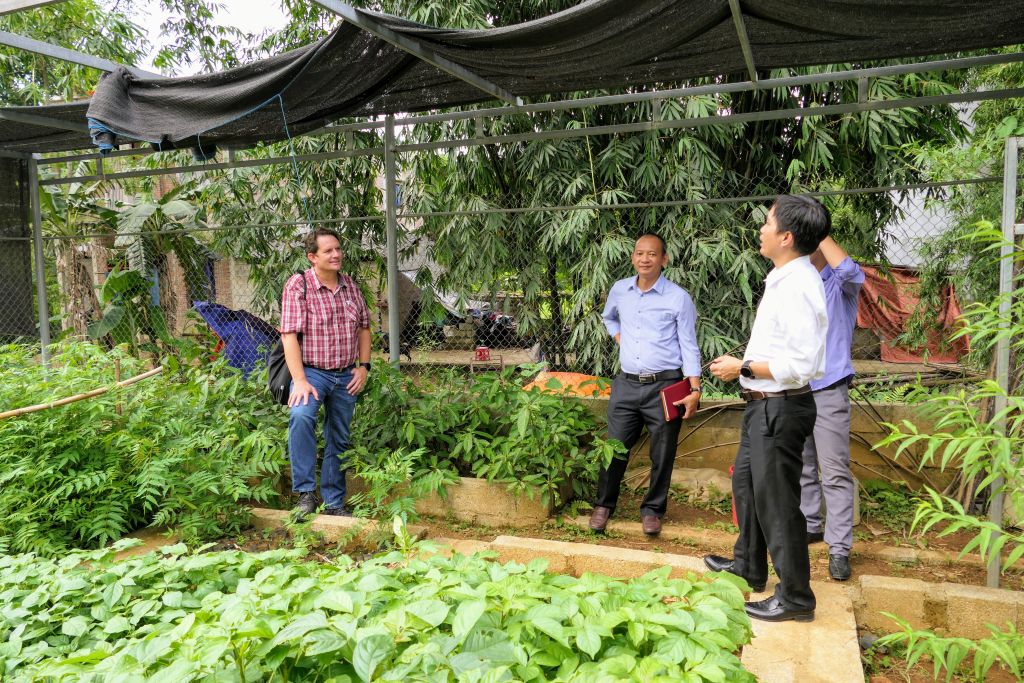 Photo: IUCN visits a nursery managed by the Keo Giao community where seedlings are grown to restore forests in the Conservation Area. © IUCN/Noor Ali
Photo: IUCN visits a nursery managed by the Keo Giao community where seedlings are grown to restore forests in the Conservation Area. © IUCN/Noor Ali
By promoting transboundary collaboration with the Vietnamese government at all levels and with strong support and participation of local communities, FFI has been able to successfully contribute to the protection of the Cao-vit Gibbon and improve management of the Species and Habitat Conservation Area. - Mr. Lam Van Hoang, FFI Vietnam Country Director.
In the future, FFI is looking to improve their understanding of gibbon activity, ecology and habitat by conducting additional research, as well as supporting local livelihoods through engagement with communities in habitat and forest management.
SOS Gibbons is a three-year initiative funded by a Private Foundation from the Netherlands. The goal of SOS Gibbons is to catalyse conservation action for some of the most threatened gibbon species through the provision of grants to Civil Society Organisations working on the frontline of conservation.
